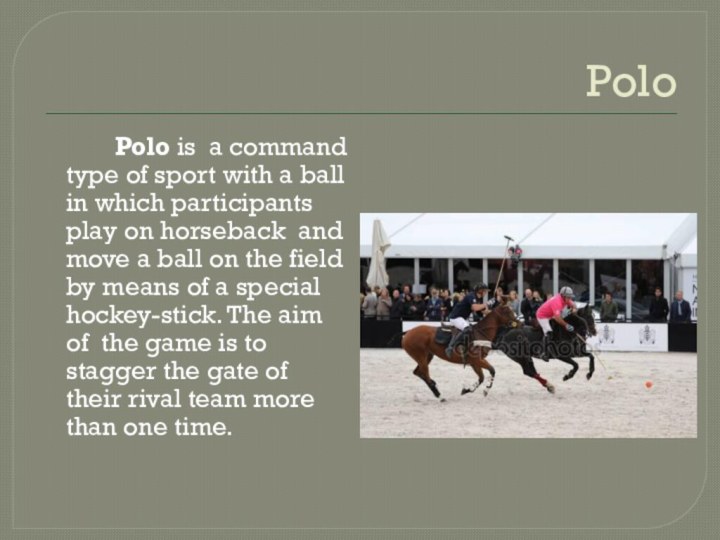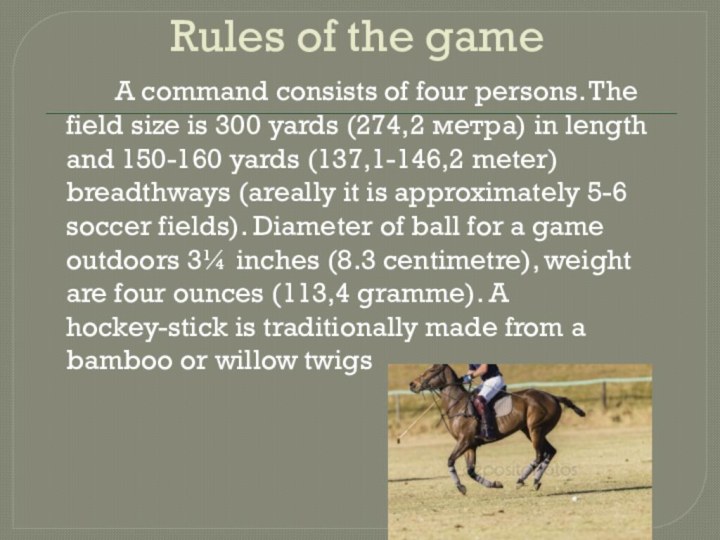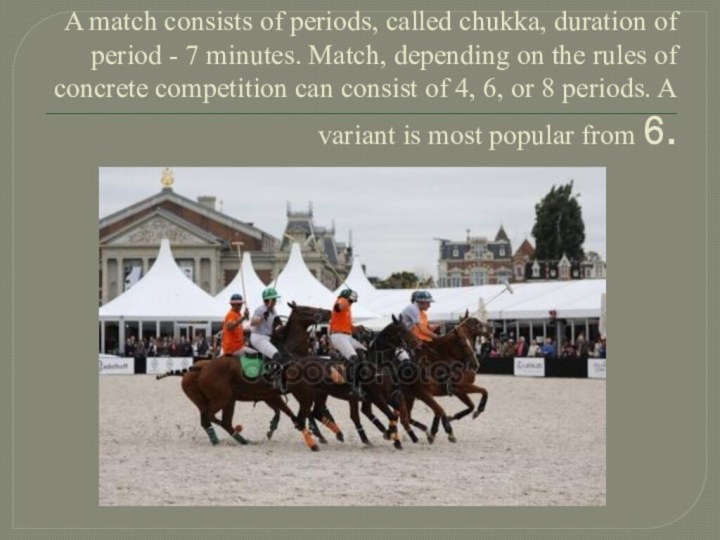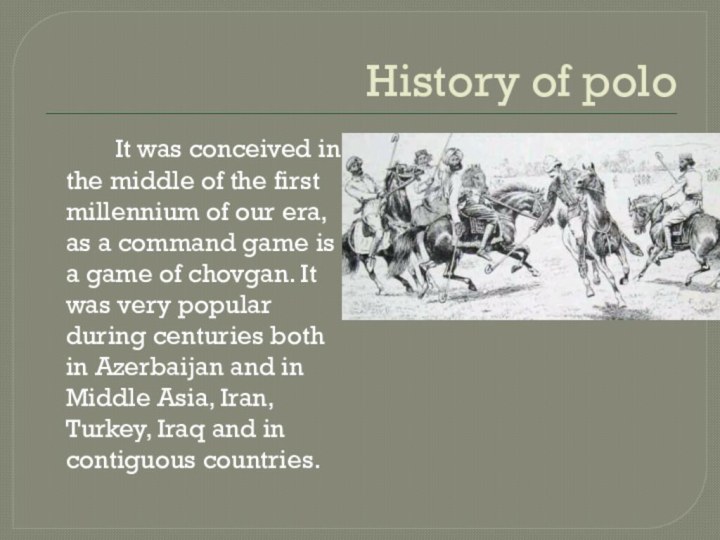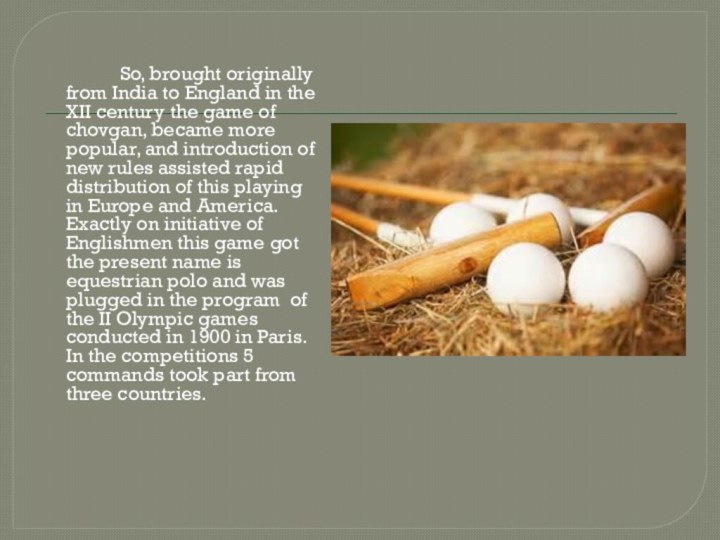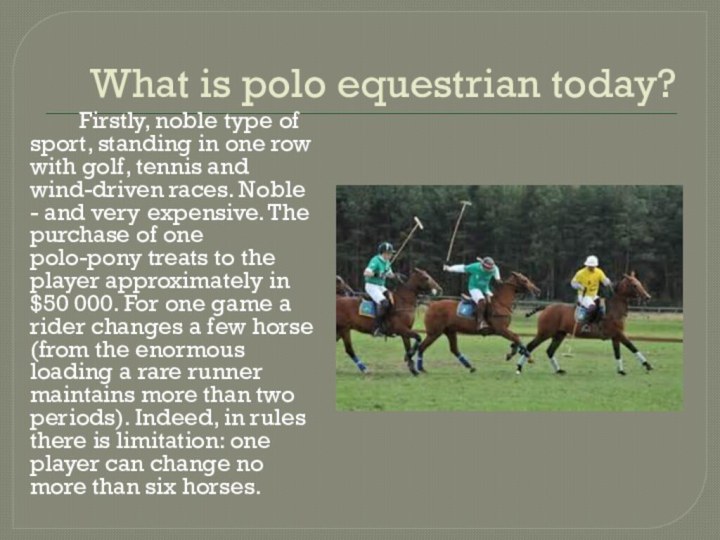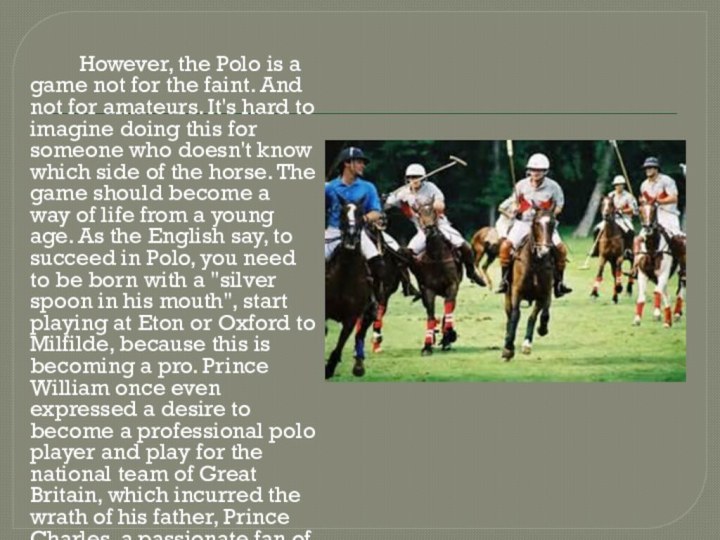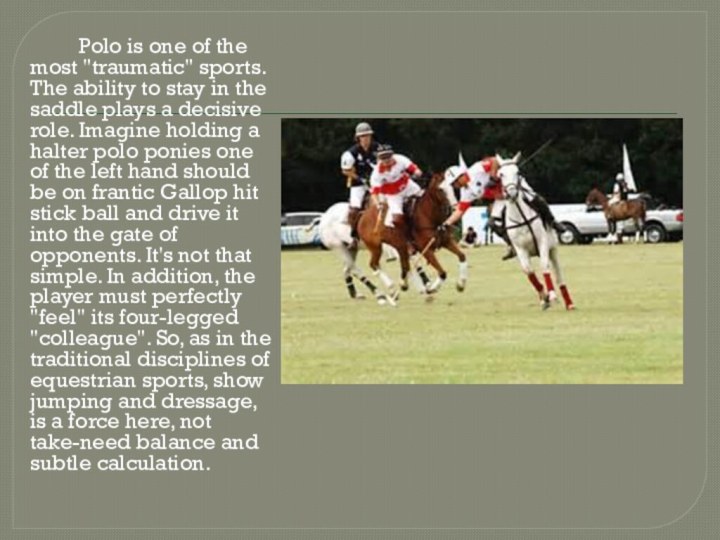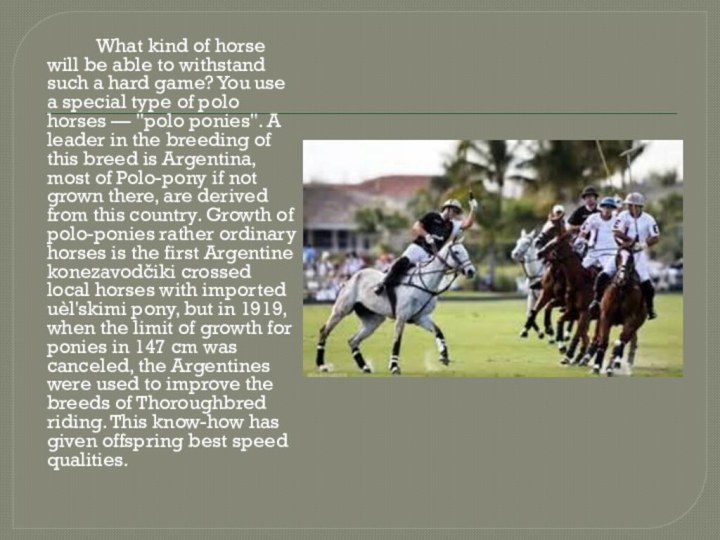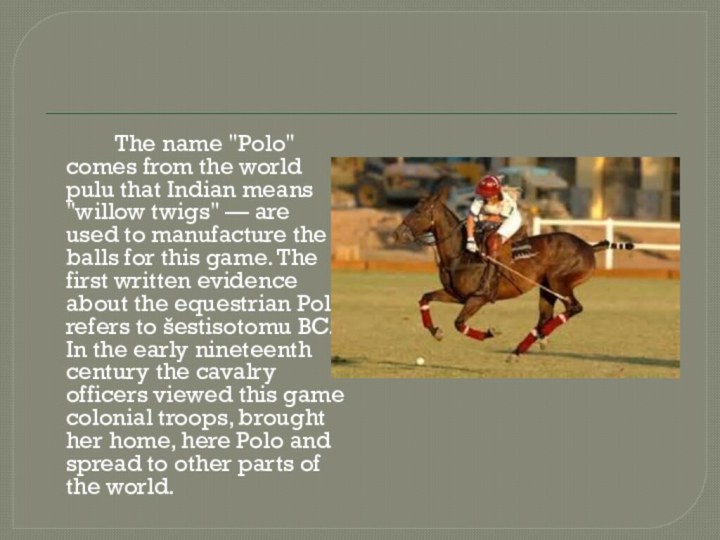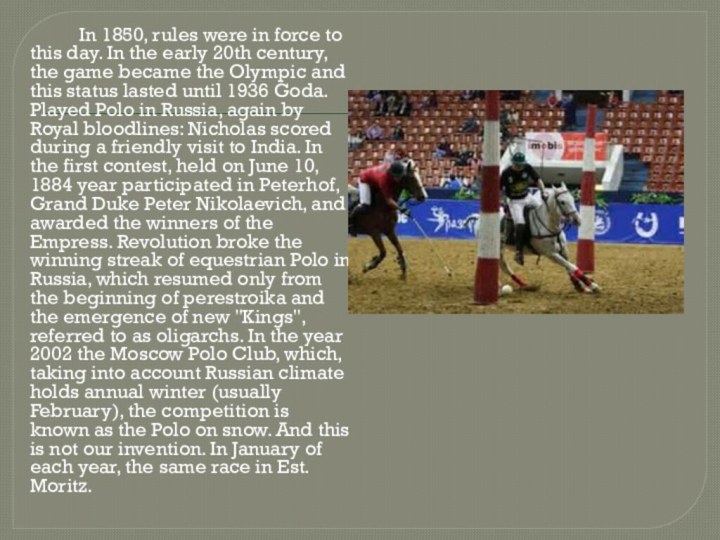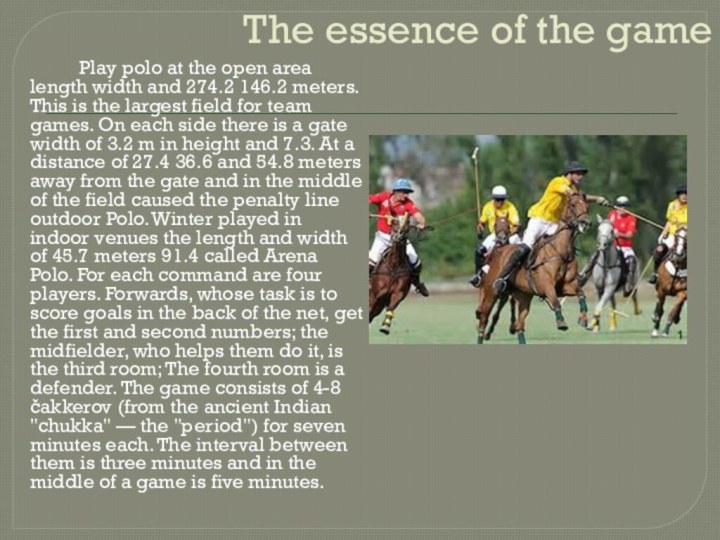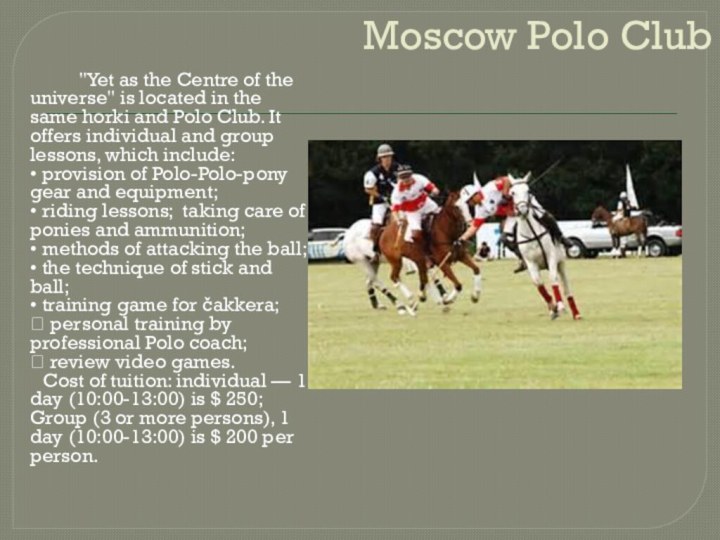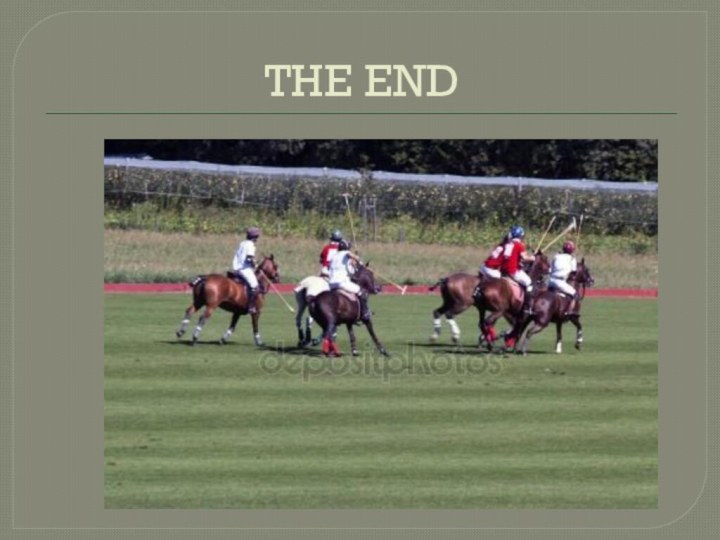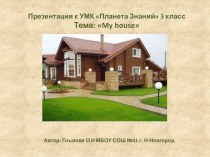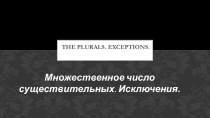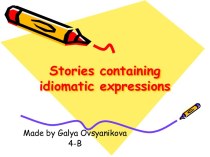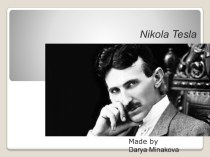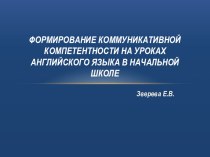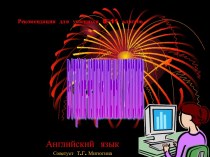Слайд 2
Polo
Polo is a command type of sport with
a ball in which participants play on horseback and
move a ball on the field by means of a special hockey-stick. The aim of the game is to stagger the gate of their rival team more than one time.
Слайд 3
Rules of the game
A command consists of four
persons. The field size is 300 yards (274,2 метрa)
in length and 150-160 yards (137,1-146,2 meter) breadthways (areally it is approximately 5-6 soccer fields). Diameter of ball for a game outdoors 3¼ inches (8.3 centimetre), weight are four ounces (113,4 gramme). A hockey-stick is traditionally made from a bamboo or willow twigs
Слайд 4
A match consists of periods, called chukka, duration
of period - 7 minutes. Match, depending on the
rules of concrete competition can consist of 4, 6, or 8 periods. A variant is most popular from 6.
Слайд 5
History of polo
It was conceived in the middle
of the first millennium of our era, as a
command game is a game of chovgan. It was very popular during centuries both in Azerbaijan and in Middle Asia, Iran, Turkey, Iraq and in contiguous countries.
Слайд 6
The fragments of the game were periodically
represented on ancient miniatures, and also the detailed descriptions
and rules of playing were given by ancient manuscripts. The first international competitions on the game of Chovgan were conducted among the horsemen of Middle East in the XII century, that time cultural capital of the Islamic world was the city Baghdad.
Слайд 7
So, brought originally from India to England
in the XII century the game of chovgan, became
more popular, and introduction of new rules assisted rapid distribution of this playing in Europe and America. Exactly on initiative of Englishmen this game got the present name is equestrian polo and was plugged in the program of the II Olympic games conducted in 1900 in Paris. In the competitions 5 commands took part from three countries.
Слайд 8
What is polo equestrian today?
Firstly, noble type of
sport, standing in one row with golf, tennis and
wind-driven races. Noble - and very expensive. The purchase of one polo-pony treats to the player approximately in $50 000. For one game a rider changes a few horse (from the enormous loading a rare runner maintains more than two periods). Indeed, in rules there is limitation: one player can change no more than six horses.
Слайд 9
The object of Polo is for a team
to score more points than its opposition, thus winning
the game. Each team attempts to move the ball into the opposition's half of the pitch with the aim of eventually hitting it through the goal to score. Each team of four is made up of attackers and defenders, but realistically all members of a polo team are expected to be flexible and make any play whether offensive or defensive and change position as necessary to benefit the team.
Слайд 10
However, the Polo is a game not for
the faint. And not for amateurs. It's hard to
imagine doing this for someone who doesn't know which side of the horse. The game should become a way of life from a young age. As the English say, to succeed in Polo, you need to be born with a "silver spoon in his mouth", start playing at Eton or Oxford to Milfilde, because this is becoming a pro. Prince William once even expressed a desire to become a professional polo player and play for the national team of Great Britain, which incurred the wrath of his father, Prince Charles, a passionate fan of Polo.
Слайд 11
Polo is one of the most "traumatic" sports.
The ability to stay in the saddle plays a
decisive role. Imagine holding a halter polo ponies one of the left hand should be on frantic Gallop hit stick ball and drive it into the gate of opponents. It's not that simple. In addition, the player must perfectly "feel" its four-legged "colleague". So, as in the traditional disciplines of equestrian sports, show jumping and dressage, is a force here, not take-need balance and subtle calculation.
Слайд 12
What kind of horse will be able to
withstand such a hard game? You use a special
type of polo horses — "polo ponies". A leader in the breeding of this breed is Argentina, most of Polo-pony if not grown there, are derived from this country. Growth of polo-ponies rather ordinary horses is the first Argentine konezavodčiki crossed local horses with imported uèl′skimi pony, but in 1919, when the limit of growth for ponies in 147 cm was canceled, the Argentines were used to improve the breeds of Thoroughbred riding. This know-how has given offspring best speed qualities.
Слайд 13
The name "Polo" comes from the world pulu
that Indian means "willow twigs" — are used to
manufacture the balls for this game. The first written evidence about the equestrian Polo refers to šestisotomu BC. In the early nineteenth century the cavalry officers viewed this game colonial troops, brought her home, here Polo and spread to other parts of the world.
Слайд 14
In 1850, rules were in force to this
day. In the early 20th century, the game became
the Olympic and this status lasted until 1936 Goda. Played Polo in Russia, again by Royal bloodlines: Nicholas scored during a friendly visit to India. In the first contest, held on June 10, 1884 year participated in Peterhof, Grand Duke Peter Nikolaevich, and awarded the winners of the Empress. Revolution broke the winning streak of equestrian Polo in Russia, which resumed only from the beginning of perestroika and the emergence of new "Kings", referred to as oligarchs. In the year 2002 the Moscow Polo Club, which, taking into account Russian climate holds annual winter (usually February), the competition is known as the Polo on snow. And this is not our invention. In January of each year, the same race in Est. Moritz.
Слайд 15
The essence of the game
Play polo at the
open area length width and 274.2 146.2 meters. This
is the largest field for team games. On each side there is a gate width of 3.2 m in height and 7.3. At a distance of 27.4 36.6 and 54.8 meters away from the gate and in the middle of the field caused the penalty line outdoor Polo. Winter played in indoor venues the length and width of 45.7 meters 91.4 called Arena Polo. For each command are four players. Forwards, whose task is to score goals in the back of the net, get the first and second numbers; the midfielder, who helps them do it, is the third room; The fourth room is a defender. The game consists of 4-8 čakkerov (from the ancient Indian "chukka" — the "period") for seven minutes each. The interval between them is three minutes and in the middle of a game is five minutes.
Слайд 16
Teams line up in numerical order. The judge
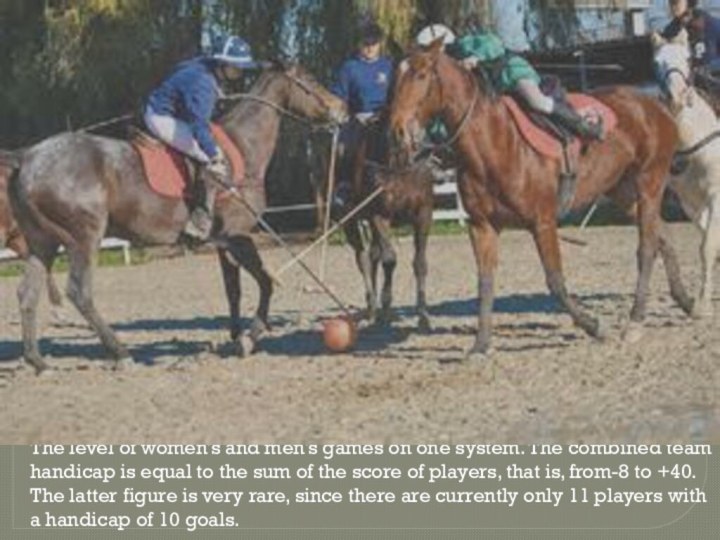
throws the ball and the players try to hammer
it into the wrong gate sticks 120-135 centimeters long, made of maple, ash or bamboo. After each team scored change gate. In the game use four major blow: direct (forehand) is to pass the ball forward or sideways to the partner on the team; reverse (backhand) is to pass the ball back; from under the neck (neckshot)-kick the ball from under the neck of the horse; tail (tailshot)-kick the ball at the back of the horse. Players can hook onto their opponent's sticks, golf clubs, but in no case is a friend of a friend or a pony. The game is managed by two riding an arbitrator, but the final word belongs to the Chief Justice, which is the middle line. In case of violation of the rules, leaving the ball outside the box, fall or injury of a pony, as judge stops the game and sometimes assigns a free kick. Shtrafnye punch from any place on the offending half of the field. Depending on the extent of the violation, the judge may or may not allow the Defender to be at the gate. Each skill is assessed by the International Federation of polo players. They are awarded a handicap of-2 to +10 goals. Handicap has nothing to do with the amount of goals expected of the person and is an indication of the skill and ability to ride. The level of women's and men's games on one system. The combined team handicap is equal to the sum of the score of players, that is, from-8 to +40. The latter figure is very rare, since there are currently only 11 players with a handicap of 10 goals.
Слайд 17
Moscow Polo Club
"Yet as the Centre of the
universe" is located in the same horki and Polo
Club. It offers individual and group lessons, which include:
• provision of Polo-Polo-pony gear and equipment;
• riding lessons; taking care of ponies and ammunition;
• methods of attacking the ball; • the technique of stick and ball;
• training game for čakkera;
personal training by professional Polo coach;
review video games.
Cost of tuition: individual — 1 day (10:00-13:00) is $ 250; Group (3 or more persons), 1 day (10:00-13:00) is $ 200 per person.

